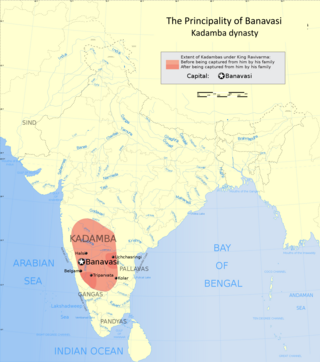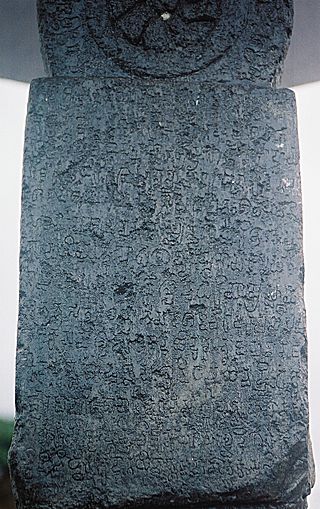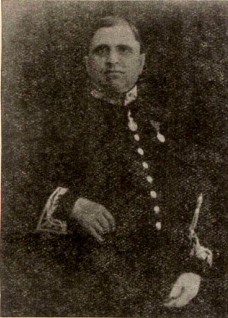Related Research Articles

The Kadambas were an ancient royal family from modern Karnataka, India, that ruled northern Karnataka and the Konkan from Banavasi in present-day Uttara Kannada district in India. The kingdom was founded by Mayuravarma in c. 345, and at later times showed the potential of developing into imperial proportions. An indication of their imperial ambitions is provided by the titles and epithets assumed by its rulers, and the marital relations they kept with other kingdoms and empires, such as the Vakatakas and Guptas of northern India. Mayurasharma defeated the armies of the Pallavas of Kanchi possibly with the help of some native tribes and claimed sovereignty. The Kadamba power reached its peak during the rule of Kakusthavarma.

The Archaeological Survey of India (ASI) is an Indian government agency that is responsible for archaeological research and the conservation and preservation of cultural historical monuments in the country. It was founded in 1861 by Alexander Cunningham during the British Raj who also became its first Director-General.

The Halmidi inscription is the oldest known Kannada-language inscription in the Kadamba script. While estimates vary slightly, the inscription is often dated to between 450 CE - 500 CE. The inscription was discovered in 1936 by Dr. M. H. Krishna, the Director of Archaeology of the (princely) State of Mysore, in Halmidi, a village in the Hassan district.
The archaeology of Ayodhya concerns the excavations and findings in the Indian city of Ayodhya in the state of Uttar Pradesh, much of which surrounds the Babri Mosque location.
Bahuriband, near Katni in Madhya Pradesh, is a famous inscription at the feet of a colossal stone image of Jain Tirthankara Shantinath. The colossal statue is 12 ft 2 in (3.71 m) in height.
Dineshchandra Sircar (1907–1985), also known as D. C. Sircar or D. C. Sarkar, was an epigraphist, historian, numismatist and folklorist, known particularly in India and Bangladesh for his work deciphering inscriptions. He was the Chief Epigraphist of the Archaeological Survey of India (1949–1962), Carmichael Professor of Ancient Indian History and Culture at the University of Calcutta (1962–1972) and the General President of the Indian History Congress. In 1972, Sircar was awarded the Sir William Jones Memorial Plaque.

Ramachandran Nagaswamy was an Indian historian, archaeologist and epigraphist who was known for his work on temple inscriptions and art history of Tamil Nadu. He was an authority on Chola bronzes.
Rai Bahadur Valaiyattur Venkayya was an Indian epigraphist and historian. He served as the Chief Epigraphist to the Government of India from 1908 to 1912.
Jettha Tissa II also known as Detutis II, was King of Anuradhapura in the 4th century, whose reign lasted 9 years from 332 to 341. He succeeded his brother Sirimeghavanna as King of Anuradhapura and was succeeded by his son Buddhadasa.
Dr. Koluvail Vyasaraya Ramesh was an Indian epigraphist and Sanskrit scholar who served as the Chief Epigraphist and Joint Director General of the Archaeological Survey of India (ASI).
Rao Bahadur Hosakote Krishna Sastri was an Indian epigraphist with the Archaeological Survey of India (ASI). He is known for his work in deciphering Brahmi inscriptions of Asoka at Maski and inscriptions of the Pallavas. Sastri edited volumes XVII, XVIII and XIX of Epigraphia Indica and authored a book titled "South Indian images of Gods and Goddesses".
Niranjan Prasad Chakravarti was an Indian archaeologist who served as the Chief epigraphist to the Government of India in 1934 to 1940 and as Director-general of the Archaeological Survey of India from 1948 to 1950.
Hiranand Sastri (1878–1946) was an Indian archaeologist, epigraphist and official of the Archaeological Survey of India who was involved in the excavation of numerous sites including Nalanda and Sankissa. His son, Sachchidananda Vatsyayan 'Agyeya', was a Hindi language poet and writer.

Rai Bahadur Daya Ram SahniCIE was an Indian archaeologist who supervised the excavation of the Indus valley site at Harappa in 1920 to 1921. The first report on Harappan excavations came out on 29 March 1921, published by John Marshall, which is why various historians have chosen 1921 AD as the period of Harappan excavation. A protege of John Marshall, in 1931 Sahni became the first Indian to be appointed Director-General of the Archaeological Survey of India (ASI), a position which he served in till 1935.
Pandit Madho Sarup Vats was an Indian archaeologist and Sanskrit scholar who served as the Director-General of the Archaeological Survey of India (ASI) from 1950 to 1954. Pandit Vats is especially well known for his participation in the excavations at Mohenjodaro which he supervised from 1924.
Ziauddin Abdul Hayy Desai was an Indian epigraphist associated with the Archaeological Survey of India (ASI). He was also a noted architectural historian and a literary scholar of the Indo-Persianate world as evidenced in his writings.
South Indian Inscriptions is an epigraphical series that has been published by the Archaeological Survey of India in 34 volumes from 1890 through the present. The texts are supplemented with summaries and an overview of the texts, both in English The series was originally edited by archaeologist E. Dinesh, then V. Venkayya and Rai Bahadur.
Estampage or stamping, is a term commonly used in epigraphy to obtain the exact replica of an inscription that cannot be transported.

The Lakshana Devi Temple in Bharmour is a post-Gupta era Hindu temple in Himachal Pradesh dedicated to Durga in her Mahishasura-mardini form. It is dated to the second half of the 7th-century, and is in part one of the oldest surviving wooden temples in India.
The Panduvamshis or Pandavas were an Indian dynasty that ruled the historical Mekala region in present-day Chhattisgarh state of India, during the 6th and the 7th centuries. The Panduvamshi kings, who were Shaivites, claimed descent from the legendary Pandavas and also claimed to be members of the lunar dynasty. They may have been Gupta feudatories, and may have been related to the Panduvamshis of Dakshina Kosala, but this cannot be said with certainty.
References
- K. V. Ramesh; Agam Prasad; S. P. Tiwari (1984). "Dr. B. Ch. Chhabra: A Biographical Sketch". Svasti Sri Dr. B. Ch. Chhabra Felicitation Volume.
- "Prominent Epigraphists of Sanskrit and Dravidian". Archaeological Survey of India.
- ↑ Ray, Purnima; Patil, C. B. (2014). Remembering Stalwarts: Biographical Sketches of Scholars from Archaeological Survey of India. Director General, Archaeological Survey of India.
- ↑ Presidential Addresses and Praśastis. Epigraphical Society of India. 1985. pp. XII.
- ↑ "Vinod Chhabra Obituary (2004) - Albany, NY - Albany Times Union". Legacy.com. Retrieved 9 December 2023.
- ↑ Journal of the Epigraphical Society of India. Vol. 8–10. The Society. 1981. p. 1.
- ↑ Bhatia, H. S. (2001). Society, Law and Administration in Ancient India. Deep & Deep. p. 167. ISBN 978-81-7100-366-2.
- ↑ The Indian P.E.N. P.E.N. All-India Centre. 1965. p. 341.